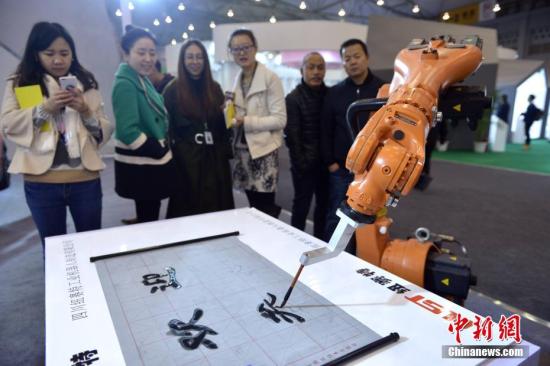Robots replace human labor beyond manufacturing bases
- By Wu Jin
 0 Comment(s)
0 Comment(s) Print
Print E-mail China.org.cn, May 3, 2017
E-mail China.org.cn, May 3, 2017
|
|
|
A robot arm writes calligraphy. [Chinanews.com] |
The smart technology leading to an explosive growth of robotic replacement for human labor has begun to flourish beyond the traditional manufacturing bases, but also in China's service industry.
According to the Ministry of Industry and Information Technology, robots have replaced humans in manual work in 5,000 industrial programs over the past four years in Zhejiang Province, involving investment totaling 500 billion yuan (US$72.5 billion).
Ling Yun, deputy director of the Zhejiang Provincial Economic and Information Technology Commission, said that, by 2015, the usual manual labor pool has slimmed down by some two million workers.
Moreover, Anhui, Guangdong and Shandong provinces are pressing ahead with robotic substitutes in their cutting-edge industries where manual jobs for both men and women are being substantially reduced.
According to the Beijing Morning Post, jobs better suited to robots comprise the assembly of intelligent vehicles, firefighting and medical care, which all benefit from the employment of industrial data analysis, information technology and 3D auxiliary design.
The workshop of Shenzhen Rapoo Technology, facing a labor shortage of labor from 2005, purchased 75 robots in 2011, with immediate benefits in declining labor costs.
Nowadays, one of its computer keyboard assembly lines needs only five workers responsible for monitoring the automatic processing by the robots that have replaced an estimated 100 workers previously employed there.
The replacement has continued to prevail by moving from assembly lines to banking and logistics.
In 2015, China Construction Bank installed a number of robots to replace staff in its call center. Currently, STO Express, one of China's leading privately- owned logistic companies, has adopted 320 robots to categorize deliveries in Linyi City, Shandong Province.
The robots can deal with 18,000 parcels weighing a maximum of five kilograms each every single hour at a high rate (often 100 percent) of accuracy. As a result, the labor force in the Linyi branch was cut by 80 percent from 150 to 30.
Despite the expansion of robots into the job market, experts have assured human workers not to overact to the smart automatic fashion as the trend can free them from the shackles of mundane toil for more complicated techniques and meaningful endeavor.
Wang Yamin, an employee from Guangdong Changying Precision High-Tech Co Ltd, said, that when the work she was doing was temporarily taken over by robots, she attended a two-month training enabling her to get a promotion to be a technician with increased salary.
"Currently, the robots, whose sensors remain weak, can only run in a certain framework," said Ding Han, dean of the Mechanical Science and Engineering School of Huazhong University of Science and Technology.
"The special robots have to complete their missions with remote controls," he added.
According to NEKKEI's Chinese news web, more and more young people receiving high education in China are not interested in repetitious manual jobs, which, in addition to the rising labor costs, are challenging the manufacturing competence of the country.
The advent of robots, which can be used for at least 10 years, helps the country, an economic locomotive in the world, sustain the momentum of economic growth.







Go to Forum >>0 Comment(s)